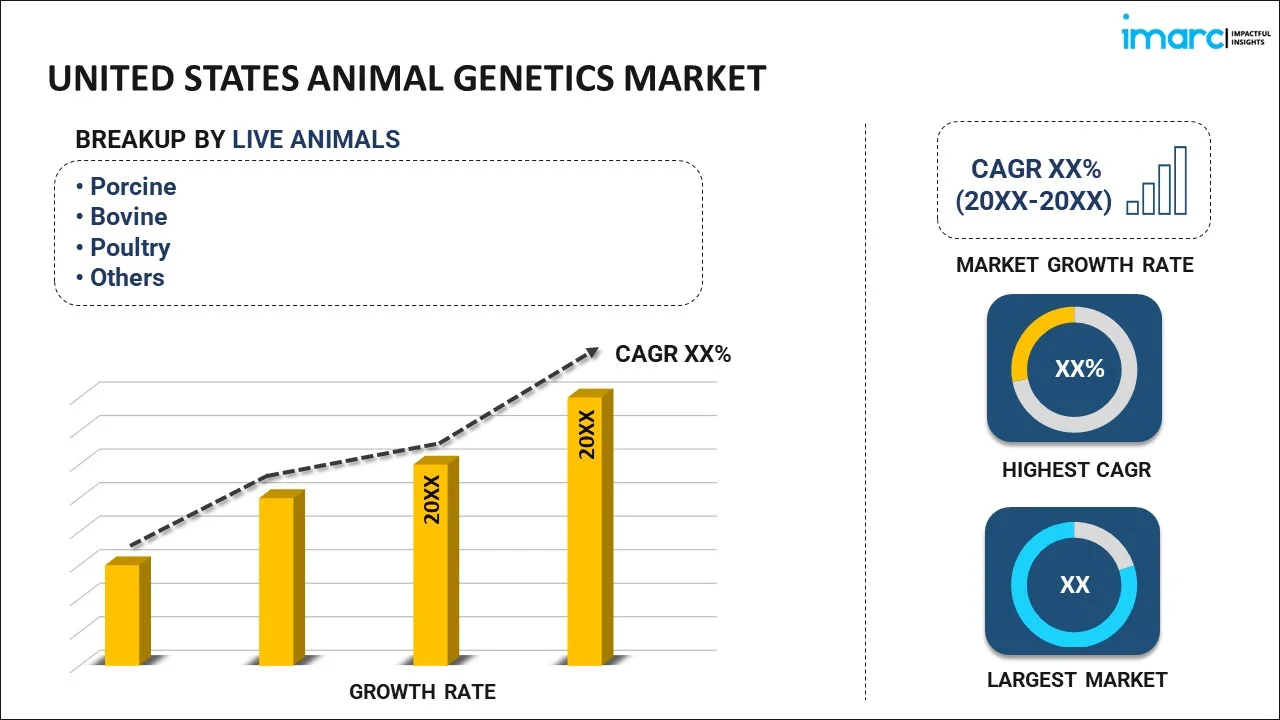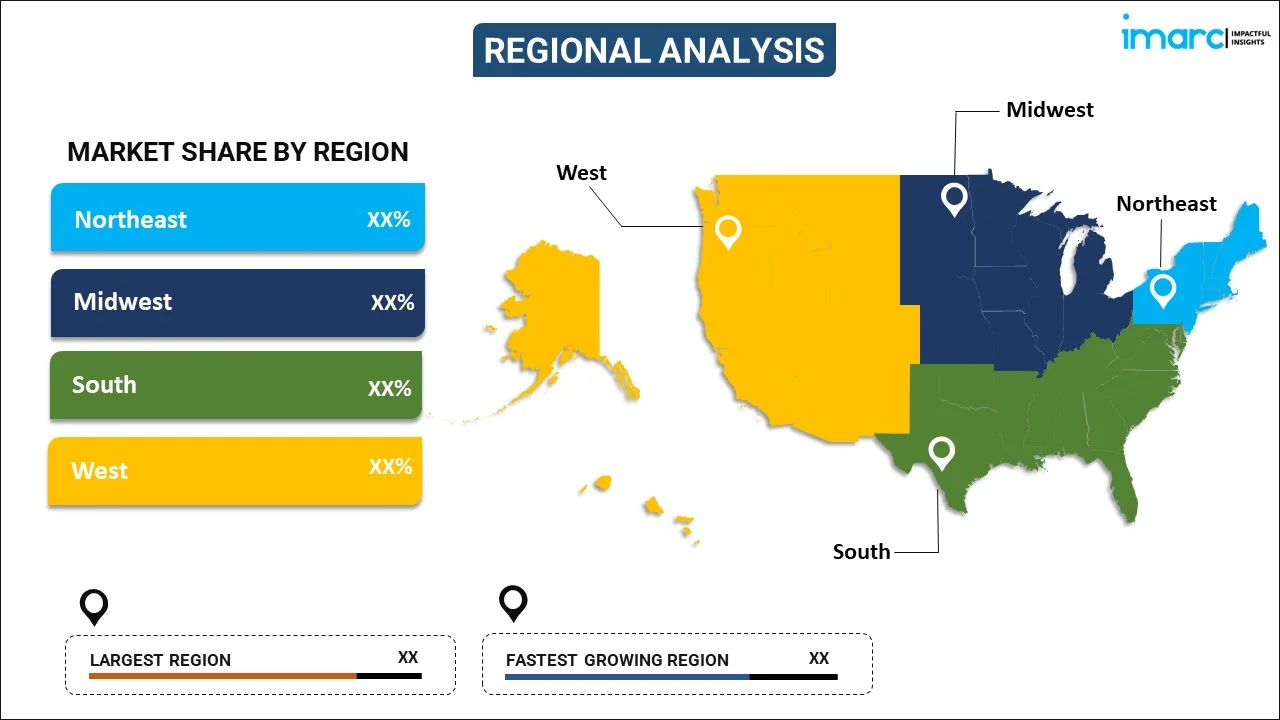
United States Animal Genetics Market Report by Live Animal (Porcine, Bovine, Poultry, Canine, and Others), Genetic Materials (Embryo, Semen), Services (Genetic Trait Testing, Genetic Diseases Testing, DNA Typing), End User (Veterinary Hospitals and Clinics, Diagnostic Centers), and Region 2024-2032
Market Overview:
United States animal genetics market size is projected to exhibit a growth rate (CAGR) of 5.20% during 2024-2032. The increasing demand for high-quality animal products, advancements in biotechnology, surging environmental sustainability, government support, growing demand for precision agriculture, rapidly expanding aquaculture, and the growth of the pet industry are some of the factors stimulating the market growth.
|
Report Attribute
|
Key Statistics
|
|---|---|
|
Base Year
|
2023 |
|
Forecast Years
|
2024-2032
|
|
Historical Years
|
2018-2023
|
| Market Growth Rate (2024-2032) | 5.20% |
Animal genetics is a branch of science that focuses on the study of genetic traits and variations in animals. It involves the examination of an animal's DNA, which contains genetic information that determines its physical characteristics, behavior, and susceptibility to diseases. It works by analyzing and manipulating the genetic material of animals to understand how certain traits are inherited and expressed. This field has a wide range of uses, including improving livestock and pet breeds, conserving endangered species, and advancing biomedical research. One of the primary ways animal genetics works is through selective breeding. Breeders identify animals with desirable traits, such as high milk production in cows or disease resistance in chickens, and mate them to pass on these traits to the next generation. Additionally, modern techniques such as artificial insemination and in vitro fertilization (IVF) allow for more precise control over the breeding process, leading to faster genetic improvement. The advantages of animal genetics include the potential for increased agricultural efficiency and sustainability. By breeding animals for improved traits, farmers can reduce the need for chemical inputs, such as antibiotics or pesticides. Furthermore, animal genetics research has advanced our understanding of various diseases, leading to the development of better diagnostics and treatments for both animals and humans.
United States Animal Genetics Market Trends:
The United States animal genetics market is influenced by several key drivers, such as the increasing demand for high-quality animal products, such as meat, dairy, and eggs. Consumers are increasingly seeking healthier and more sustainable food options, which drives the need for genetically superior animals that can produce more efficiently. In line with this, advancements in biotechnology and genetic research have allowed for more precise breeding and selection of animals with desirable traits, further fueling the market growth. Additionally, the growing focus on disease resistance and animal health is another growth-inducing factor. Genetic advancements have enabled the development of animals that are more resilient to diseases, reducing the need for antibiotics and improving overall animal welfare. Moreover, the growing awareness of the environmental impact of animal agriculture has led to a demand for animals with reduced environmental footprints, such as those that produce less methane or require less feed, which is stimulating the market growth. Furthermore, the globalization of the meat and dairy industry drives the need for genetic improvements to meet international quality and safety standards, which is propelling the market growth in the country.
United States Animal Genetics Market Segmentation:
IMARC Group provides an analysis of the key trends in each segment of the market, along with forecasts at the country level for 2024-2032. Our report has categorized the market based on live animal, genetic materials, services, and end user.
Live Animal Insights:

- Porcine
- Bovine
- Poultry
- Canine
- Others
The report has provided a detailed breakup and analysis of the market based on the live animal. This includes porcine, bovine, poultry, canine, and others.
Genetic Materials Insights:
- Embryo
- Semen
A detailed breakup and analysis of the market based on genetic materials have also been provided in the report. This includes embryo and semen.
Services Insights:
- Genetic Trait Testing
- Genetic Diseases Testing
- DNA Typing
The report has provided a detailed breakup and analysis of the market based on the services. This includes genetic trait testing, genetic diseases testing, and DNA typing.
End User Insights:
- Veterinary Hospitals and Clinics
- Diagnostic Centers
A detailed breakup and analysis of the market based on end user have also been provided in the report. This includes veterinary hospitals and clinics and diagnostic centers.
Regional Insights:

- Northeast
- Midwest
- South
- West
The report has also provided a comprehensive analysis of all the major regional markets, which include the Northeast, Midwest, South, and West.
Competitive Landscape:
The market research report has also provided a comprehensive analysis of the competitive landscape in the market. Competitive analysis such as market structure, key player positioning, top winning strategies, competitive dashboard, and company evaluation quadrant has been covered in the report. Also, detailed profiles of all major companies have been provided.
United States Animal Genetics Market Report Coverage:
| Report Features | Details |
|---|---|
| Base Year of the Analysis | 2023 |
| Historical Period | 2018-2023 |
| Forecast Period | 2024-2032 |
| Units | US$ Million |
| Scope of the Report | Exploration of Historical and Forecast Trends, Industry Catalysts and Challenges, Segment-Wise Historical and Predictive Market Assessment:
|
| Live Animals Covered | Porcine, Bovine, Poultry, Canine, Others |
| Genetic Materials Covered | Embryo, Semen |
| Services Covered | Genetic Trait Testing, Genetic Diseases Testing, DNA Typing |
| End Users Covered | Veterinary Hospitals and Clinics, Diagnostic Centers |
| Regions Covered | Northeast, Midwest, South, West |
| Customization Scope | 10% Free Customization |
| Report Price and Purchase Option | Single User License: US$ 3699 Five User License: US$ 4699 Corporate License: US$ 5699 |
| Post-Sale Analyst Support | 10-12 Weeks |
| Delivery Format | PDF and Excel through Email (We can also provide the editable version of the report in PPT/Word format on special request) |
Key Questions Answered in This Report:
- How has the United States animal genetics market performed so far and how will it perform in the coming years?
- What has been the impact of COVID-19 on the United States animal genetics market?
- What is the breakup of the United States animal genetics market on the basis of live animal?
- What is the breakup of the United States animal genetics market on the basis of genetic materials?
- What is the breakup of the United States animal genetics market on the basis of services?
- What is the breakup of the United States animal genetics market on the basis of end user?
- What are the various stages in the value chain of the United States animal genetics market?
- What are the key driving factors and challenges in the United States animal genetics?
- What is the structure of the United States animal genetics market and who are the key players?
- What is the degree of competition in the United States animal genetics market?
Key Benefits for Stakeholders:
- IMARC’s industry report offers a comprehensive quantitative analysis of various market segments, historical and current market trends, market forecasts, and dynamics of the United States animal genetics market from 2018-2032.
- The research report provides the latest information on the market drivers, challenges, and opportunities in the United States animal genetics market.
- Porter's five forces analysis assist stakeholders in assessing the impact of new entrants, competitive rivalry, supplier power, buyer power, and the threat of substitution. It helps stakeholders to analyze the level of competition within the United States animal genetics industry and its attractiveness.
- Competitive landscape allows stakeholders to understand their competitive environment and provides an insight into the current positions of key players in the market.
Need more help?
- Speak to our experienced analysts for insights on the current market scenarios.
- Include additional segments and countries to customize the report as per your requirement.
- Gain an unparalleled competitive advantage in your domain by understanding how to utilize the report and positively impacting your operations and revenue.
- For further assistance, please connect with our analysts.
 Inquire Before Buying
Inquire Before Buying
 Speak to an Analyst
Speak to an Analyst
 Request Brochure
Request Brochure
 Request Customization
Request Customization




.webp)




.webp)












